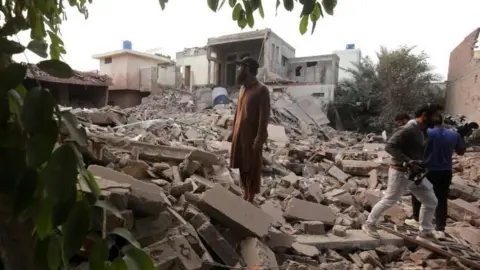On May 7, 2025, a harrowing account surfaced from the Pakistani city of Muridke, where the aftermath of a military strike against a complex, thought to be associated with militant groups, painted a grim picture. This event unfolded shortly after an Indian missile strike that targeted buildings close to the sensitive border with India in Punjab, mere minutes from Lahore. Eyewitnesses recounted their experiences in the wake of this violent incident, portraying scenes that were both terrifying and unsettling.
The strikes were part of India’s military response to recent violence in Indian-administered Kashmir, which included the deaths of tourists in Pahalgam, further intensifying the already fraught tensions between the two nuclear-armed neighbors. As details emerged, reports indicated that various structures, including a mosque, hospital, and educational facilities, formed part of the complex that faced the brunt of the attack. Many locals had gathered outside the complex on that particular Wednesday morning to witness the destruction, creating an atmosphere rife with anxiety and sorrow.
Witness accounts painted a vivid tableau of the immediate moments preceding and following the strikes. One local resident described how “the sky lit up,” stating, “it felt like the sky turned red.” This dramatic imagery underscored the chaos and panic that ensued during the strikes. Another man recounted hearing a missile’s blast: “A sudden missile appeared, and there was a blast. I immediately got out of the house,” he said, reflecting the surreal nature of the unfolding chaos. The alarming sounds of the missile strikes echoed throughout Muridke, as people scrambled for shelter amidst the tumult.
As journalists and emergency responders arrived on-site, the security situation was tightly controlled by local authorities, preventing entry into the severely damaged compound. This complex, once affiliated with the notorious Lashkar-e-Taiba (LeT), had a history that likely contributed to its targeting by the Indian military. Despite being designated as a terrorist organization by international bodies and having undergone a ban in Pakistan, remnants of its past lingered, marking the site as a potential target in the regional struggle.
Images and reports set against the backdrop of a collapsed building and debris spread across the area starkly illustrated the consequences of military action. Emergency teams were diligently sifting through the rubble, searching for any survivors while simultaneously seeking information about potential casualties. Amidst this turmoil, it was crucial to comprehend why such a complex was targeted. A few years prior, the premises had notably housed groups like Jamaat-ud-Dawa, often described as a front for LeT, raising questions about the lingering threat associated with the area’s historical associations.
The strikes against Muridke serve as a poignant reminder of the murky pathways of Indo-Pak relations, especially in regard to Kashmir, where both countries contest territorial claims. Though Pakistani officials have denied any involvement in the Pahalgam attacks, India’s military remained steadfast, asserting that the strikes aimed to dismantle what they claimed were terror infrastructures. Muridke, specifically, had served as a refuge for local students studying at the madrasa, with many children having been evacuated prior to the night’s events.
As the day progressed and journalists were allowed closer access to the damage, the extent of the destruction became apparent. A building’s roof had crumbled, and gaping holes punctuated walls where powerful blasts had reverberated. With each report emerging from the region, a collective hope resonated among civilians: a yearning for peace and a fear of further violence, as people grappled with the weighty implications of military conflict on everyday life.
In conclusion, the unfolding situation in Muridke reflects a profound cycle of violence and retribution, where remnants of militant pasts haunt the recovery efforts in Pakistan. As the emotional toll mounts amidst such conflicts, the local populace’s aspirations for normalcy remain a faint flicker in the shadow of warfare, underscoring the need for renewed dialogue and lasting peace between India and Pakistan.



